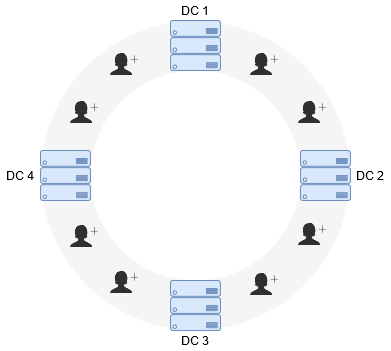What is Active-Active Mode?
In the Active - Active mode, you can accommodate as many data centers as you want. In this mode, all data centers are up and running. Each data center can handle and process the requests from the client. Here the data centers are located in ring topology and with consistent hashing technique, the load gets balanced with average 1/N uniform load across the data centers. With consistent hashing technique and replication factor 2, each data center maintains up-to-date copies of data of the immediate data center in clockwise direction. In the event of a catastrophe, if any one of the data centers goes down then all the requests handled by that data center are handled by the next near-by data center in clockwise direction.
For example, if DC 1 in the above depicted figure goes down, then the two requests that were handled by DC 1 are handled by DC 2.
Note:
API Gateway automatically federates the following volatile data only:
1. Applications (API consumers)
2. Oauth tokens and Auth code
3. Oauth or OpenID scopes (scope mapping)
4. Application registration to the API
Other data such as APIs, and so on should be promoted to the secondary data center using CI/CD pipelines.
Set up the Cross-DC support in API Gateway in the active-active mode using one of the following methods:
You can configure the data centers individually using a basic operation, where each data center is considered as a unit. This set up requires finer details like node name to configure the data centers at unit level. In case the configuration procedure encounters an error, it is easier to troubleshoot, because the configuration is done at unit level. You can reconfigure that data center, which causes the problem, in no time. Choose this method, if you want to configure less number of data centers in your environment at a unit level.
You can configure the data centers simultaneously using a composite operation. This composite operation includes setting up the data center and establishing connection between data centers. All the data centers are configured simultaneously, and configuring the data centers takes less time. This method requires basic details such as host name, port, and so on to configure the data center. In case the configuration procedure encounters an error, you must reconfigure all the data centers. Choose this method, if you want to configure more number of data centers in your environment simultaneously.

